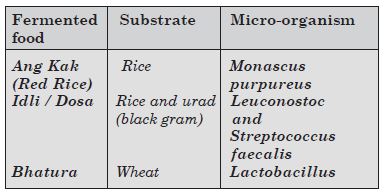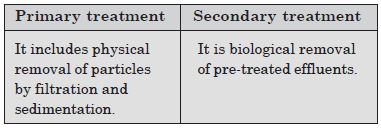Question 1:
Bacteria cannot be seen with the naked eyes, but these can be seen with the help of a microscope. If you have to carry a sample from your home to your biology laboratory to demonstrate the presence of microbes under a microscope. Which sample would you carry and why ?
Answer:
The sample that can be easily carried is the curd. It is simply because the curd contains the lactic acid bacteria (Lactobacillus) in large amount, so they can be easily observed. Lactic acid bacteria are also non-pathogenic, so there will be no risk of infection in case of mishandling.
Question 2:
Give examples to prove that microbes release gases during metabolism.
Answer:
1. Large holes in ‘Swiss Cheese’ are due to production of large amount of CO2 by a
bacterium named Propionibacterium sharmanii.
2. The puffed up appearance of dough is due to the production of CO2 gas by
yeast, Saccharomyces cerevisiae.
3. Methane, H2S and CO2 are produced during microbial digestion of
organic compounds in case of secondary treatment of sewage.
4. Dung of the cattle produces methane gas in the biogas plants.
Question 3:
In which food would you find lactic acid bacteria ? Mention some of their useful applications.
Answer:
Lactic Acid bacteria (LAB) is found mainly in the curd (yoghurt). Lactobacillus produces
large amount of lactic acid, due to which they are used in the production of fermented food.
They also improve the nutritional quality of curd by increasing vitamin B12.
Kaffir beer is prepared from Sorghum by Lactobacillus delbreuckii, Yoghurt is prepared from
milk by Lactobacillus bulgaricus and Kefir (fermented milk) is prepared from milk by
Lactobacillus sp.
LAB are also found in human stomach where they prevent the growth and multiplication of
certain disease causing microbes.
Question 4:
Name some traditional Indian foods made of wheat, rice and Bengal gram (or their products which involve using microbes).
Answer:
Traditional Indian Foods :

Question 5:
In which way microbes have played a major role in controlling diseases caused by harmful bacteria ?
Answer:
Antibiotics produced by microbes play a major role in controlling diseases caused by harmful
bacteria. Antibiotics are biologically active against a large number of organisms even in
extremely low concentration. Antibiotics are secondary metabolites and these accumulate
either inside the cell or secreted outside the cell, so that they can be purified and used
against pathogenic bacteria.
Example : Penicillin produced by Penicillium chrysogenum is active against various species
of Staphylococci and Streptococci.
Question 6:
Name any two species of fungus, which are used in the production of antibiotics.
Answer:
Penicillium chrysogenum
Penicillin Cephalosporium
Cephalosporin acremonium
Question 7:
What is sewage ? In which way can this be harmful ?
Answer:
Sewage. It is used and waste water consisting of human excreta, wash waters and industrial
and agricultural wastes that enter the sewage system. In general, sewage contains 95.5%
water and 0.1 to 0.5% organic and inorganic matter.
Harmful effects of sewage. 1. They are very harmful to us due to presence
of variety of microorganisms in them, most of which are highly pathogenic.
2. Sewage has high BOD value, there develops anaerobic conditions in water which results in
death of water animals and emitting foul smell due to incomplete oxidation of organic
materials in the sewage.
Question 8:
What is the key difference between primary and secondary sewage treatment ?
Answer:
Differences between primary treatment and secondary treatment

Question 9:
Do you think microbes can be used as source of energy ? If yes, how ?
Answer:
Yes, microbes can be used as source of energy. Biogas (predominantly methane) is produced from dung, agriculture residue by methanogenic bacteria. Biogas is the rich source of energy, it is used for cooking and lightning purposes, also used in internal combustion engines to power pumps and electric generators.
Question 10:
Microbes can be used to lessen the burden of use of chemical pesticides. Explain how this can be accomplished.
Answer:
Microbes have greatly lessened the burden of use of chemicals and pesticides. This has been
probably made successful by the use of transgenic plants and biocontrol agents
(bioinsecticides and bioherbicides).
Genes for resistance to various biotic stresses have been engineered to generate transgenic
plants that are resistant to insects, viruses, etc.
Example. Bt Cotton has been made which contains gene from the bacterium, Bacillus
thuringiensis that encodes for the Cry proteins. These crystal proteins possess the
insecticidal activity against Lepidopteran, Dipteran and Coleopteran insects.
Question 11:
Three water samples namely river water, untreated sewage water and secondary effluent
discharged from a sewage treatment plant were subjected to BOD test. The samples were
labelled A, B and C; but the laboratory attendant did not note which was which. The BOD
values of the three samples A, B and C were recorded as 20mg / L, 8mg / L, and 400 mg / L,
respectively. Which sample of the water is most polluted ?
Can you assign the correct label to each assuming the river water is relatively clean ?
Answer:
BOD measures the milligrams of oxygen
consumed during the biological decomposition of organic
matter occurring in a litre of waste water during a specified period of time. Untreated
sewage water is most polluted as it contains high amount of human excreta, wash waters and
industrial and agricultural wastes, so it has highest BOD value. Though river water is
clean, contains less organic material, thus it has least BOD value among all. So they can be
labelled as :

Question 12:
Name the microbes from which Cyclosporin A (an immunosuppressive drug) and Statins (blood cholesterol lowering agents) are obtained.
Answer:
1. Cyclosporin A is produced by Trichoderma polysporum.
2. Statin (lovastatin) is produced by Monascus purpureus.
Question 13:
Find out the role of microbes in the following and discuss it with your teacher.
(a) Single cell protein (SCP)
(b) Soil
Answer:
(a) Single Cell Protein (SCP) are basically produced from the microbes, for example Candida
utilis, Chlorella, Spirulina, Saccharomyces. SCP may be used directly as human food
supplement or else it can be used in animal feed as protein-rich supplement.
(b) Soil. It is a unique habitat which harbours a variety of microflora and fauna, and gives
mechanical and nutritional support to higher plants on which human civilization is
based.
Examples. The rhizosphere micro-organisms have beneficial effects on the development of
plant. The microorganisms catalyze the reactions in the rhizosphere and produce
CO2 and form organic acids
that in turn solubilize the inorganic nutrients of plants. Some of the rhizosphere
micro-organisms also produce growth stimulating substances.
Question 14:
Arrange the following in the decreasing order (most important first) of their importance, for the welfare of human society. Give reasons for your answer. Biogas, Citric acid, Penicillin and Curd.
Answer:
1. Penicillin. It is an antibiotic. It is used to control number of
bacterial diseases such as syphilis, gonorrhoea, diphtheria, lung infection etc.
2. Biogas. It is ecofriendly gas used as fuel. The slurry produced by its production is used
as manure.
3. Curd. It is a milk product commonly used as food.
4. Citric acid. It is used as preservative of many food items.
Question 15:
How do biofertilizers enrich the soil ?
Answer:
Biofertilizers play a vital role to solve the problems of soil fertility and soil
productivity.
1. Anabaena azollae, a cyanobacterium lives in symbiotic association with the free floating
water fern, Azolla. The symbiotic system Azolla-Anabaena complex is known to contribute
40-60 mg N ha-1 per rice crop.
In addition to this, cyanobacteria add organic matter, secrete growth promoting substances
like auxins and vitamins, mobilise insoluble phosphate and thus improves physical and
chemical nature of the soil.
2. Rhizobium leguminorserum and Azospirillum fix atmospheric nitrogen as nitrates and
nitrites.
3. Mycorrhizae formed by association of bacteria and roots of higher plants increase soil
fertility.
